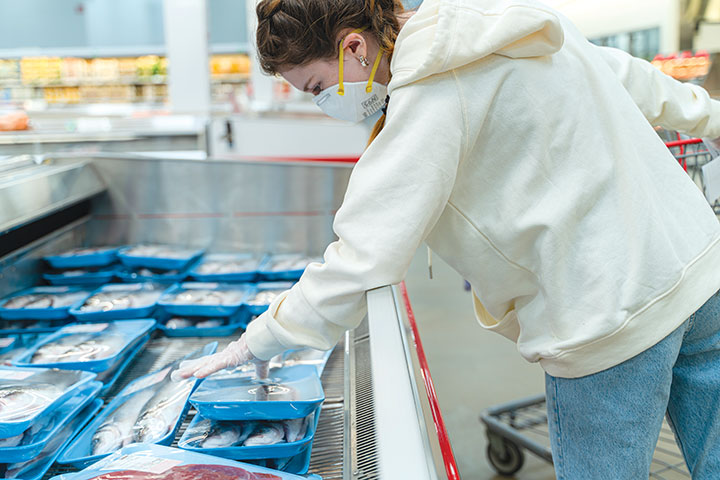
Opportunities for aquaculture as seafood gains ground
March 29, 2021
By
Liza Mayer
The pandemic created new seafood consumers but the industry has work to do to keep them post-COVID
 New seafood consumers have no bias against farmed seafood, says a retail executive
Photo: Getty Images/Alex Potemkin
New seafood consumers have no bias against farmed seafood, says a retail executive
Photo: Getty Images/Alex Potemkin Seafood gained new customers since the onset of the COVID-19 pandemic, presenting opportunities for aquaculture to deepen consumer education about farmed seafood in order to keep the momentum.
Data from industry association Food Marketing Institute (FMI) shows more Americans ate more seafood a home as food establishments shut down, boosting seafood retail sales by 28 percent to $16.5 billion in 2020 over 2019.
In its latest annual “Power of Seafood” report, FMI said that those who were already eating seafood frequently (defined as two or more times per week as per US dietary guidelines) increased from 25 percent in 2019 to 32 percent during 2020.
The number of “non-seafood eaters,” which includes those who eat seafood only in food establishments, declined from 43 percent to 38 percent.
An executive at Meije Inc, a 240-strong supermarket chain throughout the Midwest, corroborates the trend. Seafood buyer/merchandiser David Wier saw a “large growth” in the number of new seafood customers in 2020, and noted that these new customers have no bias against farmed seafood.
“When you have a new customer and new to the category, they don’t have those tough beliefs on wild-caught or farm-raised. They’re just coming in for seafood. And they’re going online to get recipes for seafood, which the industry has done a tremendous job of, thankfully,” Weir told the participants at the Seafood Expo Reconnect virtual conference in March.
But “a wild-caught customer is a wild-caught customer,” he said. “You always have to have product for them. You don’t even try to move them over (to farmed seafood) because that’s who they are and that’s what they want. We just need to take care of them.”
The shutdown of foodservice establishments where consumers usually eat seafood has a lot to do with the trend, say experts, but seafood’s reputation as a healthy protein may also have been a factor.
“I certainly believe that was part of the decision as all of a sudden we have this global pandemic. They’re thinking, ‘I need to be healthy, I know seafood is healthy so I’m going to jump on it’,” said Guy Pizzuti, seafood category manager for the $36-billion Publix supermarket chain headquartered in Florida.
Fresh crab sales posted the biggest spike in sales (60 percent) to reach $1.3 billion in 2020 over 2019, as consumers felt like indulging themselves by cooking “elevated at-home meals.”
Salmon came in second with a 19.5-percent sales growth from the previous year to reach $2.2 billion, the highest sales total among seafood categories. HMI noted that salmon buyers do not purchase any other type of fish thus offering suppliers an opportunity to offer them additional, complementary products.
The panelists believe “a sizeable chunk” of the new customers that seafood gained during the pandemic will largely remain even after restaurants re-open.
“I think when a customer learns to cook their seafood, they can’t unlearn it. They have now accomplished something that they may not have accomplished before, so FMI is bullish that there’ll be a lot more eating at home even when restaurants open back up,” said Rick Stein, VP of Fresh Foods at FMI.
“The pandemic is an unfortunate event and catastrophic event, but the seafood industry, especially retail, has been handed an opportunity that we would never have had. I mean there’s no way our numbers would have been where they’re at today. I think there’s an opportunity to continue to maintain the momentum,” added Pizzuti of Publix.
These include continuing educational initiatives on the health benefits of seafood, showing consumers how easy it is to prepare it and sharing knowledge with the purpose of building trust.
“Consumers are really, really big on proteins and everyone’s in the protein business, but there’s no better protein than the ones we provide,” said Jason Pride, vice-president of meat/seafood operations for Hy-Vee, a 265-strong chain of supermarkets in the Midwestern United States.
But seafood’s gains at retail aren’t enough to cover the sector’s losses in the foodservice segment, which accounts for roughly 60 percent of seafood volumes.
“We need food service and restaurants to come back,” said Wier of Meije. “We need them for the innovation that they provide, and for the supply, frankly. We sell a lot of lobster tails, but not lobster meat. So we need their help in things like that. We need those guys to come back and really make the entire seafood business stronger.”
Retailers expect logistical problems and pressure on supply when the foodservice industry reopens but it’s nothing that constant communication in the entire value chain can’t help assuage, they said.
“Relationship building and that constant contact are key, making sure the we’re aligned in everything that we do on the supply chain side. As restaurants start opening up, they’re going to take part of that supply as well,” said Pride.
“Don’t leave us hanging,” concurred Pizzuti. “Let us know what’s going on so we can plan alongside with you to take that next step for when the restaurants reopen. Let’s work our way through how this is going to happen versus just leaving us hanging out there.”
Advertisement
- Atlantic Sapphire reports fish mortality in Florida RAS facility
- Atlantic Sapphire appoints new COO following fish mortality incident





